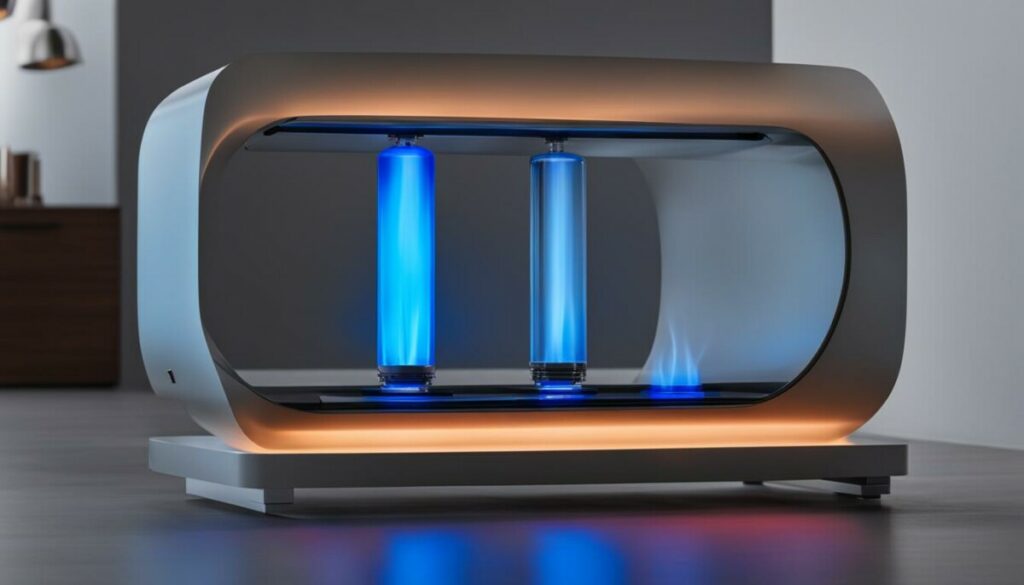Last Updated on 5 months by Francis
When the temperatures drop, the last thing we want is a cold, uncomfortable home. That’s where space heaters come in, providing warmth and comfort in colder months. But with so many heater options available, it’s easy to get confused about which one is right for you. In this article, we will compare two popular types of space heaters: blue flame heaters and infrared heaters. We will analyze their unique features, efficiency, safety, and heating outputs, helping you make an informed decision.
Contents
Key Takeaways:
- Blue flame heaters and infrared heaters are both effective options for heating your home, but differ in their specific features and capabilities.
- Blue flame heaters use convection heating, while infrared heaters use radiant heat.
- Efficiency, safety, and heating features are all important factors to consider when choosing between blue flame and infrared heaters.
- The best choice ultimately depends on your heating needs and personal preferences.
- Don’t forget to consider energy usage and cost when making your final decision.
Understanding Blue Flame Heaters

Blue flame heaters are a type of gas heater that are highly popular for their efficient and cost-effective heating capabilities. Unlike electric heaters, which rely on electricity to produce heat, blue flame heaters use propane or natural gas to create heat. This makes them an excellent option for areas with limited electricity or for those who want to save on their energy bills.
One of the main benefits of blue flame heaters is their ability to heat up large spaces quickly. They work by releasing a blue flame that heats the air in the room, which then circulates to warm up the entire area. This method of heating is highly efficient and can provide consistent warmth throughout the room.
Compared to infrared heaters, blue flame heaters offer several advantages. Firstly, they are generally more affordable and require less maintenance over time. Additionally, blue flame heaters are highly effective at heating up large rooms, making them a great option for those who need to heat a bigger space.
Benefits of Blue Flame Heaters
There are several benefits to using a blue flame heater, including:
- Effective heating of large spaces
- Quick and efficient heating capabilities
- Cost-effective compared to electric heaters
- Easy installation and maintenance
Advantages of Blue Flame Heaters over Infrared Heaters
In comparison to infrared heaters, blue flame heaters offer several unique advantages. Firstly, blue flame heaters are better suited for heating larger spaces, as they distribute heat evenly throughout the room. Additionally, blue flame heaters are less expensive to operate than their infrared counterparts, making them a great choice for those who want to save on energy costs over time.
Another advantage of blue flame heaters is their ease of maintenance. Unlike infrared heaters, which require regular cleaning and replacement of heating elements, blue flame heaters are durable and low-maintenance, providing long-lasting performance without requiring a lot of upkeep.
“Blue flame heaters are an excellent option for those who want efficient and cost-effective heating capabilities.”
Exploring Infrared Heaters

Infrared heaters are a type of radiant heater that emit heat through electromagnetic radiation. They work by heating objects and people in a room directly, rather than heating the air like blue flame heaters. This makes them a perfect choice for outdoor use during cool weather.
One of the biggest advantages of infrared heaters is their energy efficiency. They use less energy than blue flame heaters due to their ability to target specific areas, thereby reducing overall energy consumption. Infrared heaters can also be used in larger, more open spaces, making them a better choice for outdoor heating.
Infrared heaters are also known for their safety features. They do not emit carbon monoxide or other harmful pollutants, making them a safer option for heating your indoor or outdoor space. They also do not get as hot as blue flame heaters, reducing the risk of accidental burns.
Another advantage of infrared heaters is their quiet operation. They do not use noisy fans like blue flame heaters, making them a better choice if you prefer a quieter heating experience.
Did you know? Infrared heaters are often used in healthcare facilities due to their ability to reduce the spread of airborne infectious diseases.
However, infrared heaters do have some drawbacks. They are not as effective in larger spaces, especially those with high ceilings. They also require a direct line of sight to the objects being heated, so they may not be suitable for certain room layouts.
Additionally, infrared heaters can be more expensive than blue flame heaters, although they may save you money in the long run due to their energy efficiency.
In summary, infrared heaters offer many benefits over blue flame heaters. They are energy efficient, safe, quiet, and perfect for outdoor use. However, they may not be as effective in larger spaces and can be more expensive. Consider your heating needs and preferences when deciding which type of heater to choose.
Efficiency Comparison

When deciding between blue flame heaters and infrared heaters, it’s essential to consider their efficiency levels. Let’s compare the differences between blue flame and infrared heaters:
| Efficiency Factors | Blue Flame Heater | Infrared Heater |
|---|---|---|
| Energy Consumption | Blue flame heaters consume more energy to generate heat as they heat the air before circulating it in the room. | Infrared heaters are more efficient as they directly heat objects, and the heat is not lost through air circulation. |
| Heat Distribution | Blue flame heaters provide heat through convection, which spreads the heat to all parts of the room, but it takes longer to heat the room. | Infrared heaters provide spot heating, meaning they mainly heat the area they are directed towards. However, they heat the room much faster than blue flame heaters. |
| Overall Effectiveness | Blue flame heaters are suitable for heating larger spaces and can maintain consistent heat levels. However, they take longer to heat the room, which can be an issue if you need the heat quickly. | Infrared heaters are highly effective in heating smaller areas and provide fast heat. However, they are not as efficient in heating large spaces as they primarily heat a specific area. |
Based on these efficiency factors, it’s clear that choosing between blue flame and infrared heaters depends on your specific heating needs. If you have a larger space to heat and require consistent heat, a blue flame heater may be the better option. However, if you need to heat a smaller area quickly, an infrared heater may be the way to go.
Safety Considerations

When choosing a heater, safety is a critical consideration. Blue flame heaters and infrared heaters have distinct safety features that set them apart from one another. Below, we will compare their safety characteristics.
Blue Flame Heaters
Blue flame heaters use a process called convection heating to warm the room’s air. They are typically equipped with an oxygen depletion sensor (ODS), which shuts off the heater if it detects low oxygen levels in the room. This safety feature prevents fires and carbon monoxide poisoning.
In addition to the ODS, blue flame heaters also have a tilt switch. This switch automatically turns off the heater if it falls over, preventing damage to the unit and potential fire hazards.
Infrared Heaters
Infrared heaters use radiation to heat objects and people in the room. Because they do not heat the air, they do not require ventilation and are generally safer to use. They also do not produce carbon monoxide or other harmful gases, making them ideal for people with respiratory issues.
However, it is important to keep flammable materials away from the heater, as they can cause a fire. Infrared heaters also have overheating protection, which turns off the unit if it gets too hot.
Comparing Blue Flame and Infrared Heaters
While both types of heaters have safety features, there are differences in how they operate. Blue flame heaters use convection heating, which can be a potential fire hazard if the unit falls over, while infrared heaters do not require ventilation. However, infrared heaters can be a fire hazard if flammable materials are placed too close to them.
| Blue Flame Heaters | Infrared Heaters |
|---|---|
| – Oxygen depletion sensor | – No emissions or harmful gases |
| – Tilt switch for safety | – Overheating protection |
| – Can be a fire hazard if knocked over | – Can be a fire hazard if flammable materials are placed too close to the heater |
Overall, both types of heaters are safe to use, but it is essential to use them correctly and follow the manufacturer’s instructions to prevent accidents.
Heating Features

When it comes to heating features, blue flame heaters and infrared heaters differ in several key areas. Let’s take a closer look at the differences:
| Feature | Blue Flame Heater | Infrared Heater |
|---|---|---|
| Heat Output | Blue flame heaters produce a lot of heat quickly, making them ideal for smaller spaces. | Infrared heaters emit less heat than blue flame heaters, but their heat is more concentrated. They are better suited for larger areas and can also be used outdoors. |
| Heating Range | Blue flame heaters provide heat in all directions, making them ideal for heating single rooms. | Infrared heaters emit heat in a specific direction, allowing you to target specific areas. They are useful for heating larger spaces like patios. |
| Control Options | Blue flame heaters come with basic temperature controls that allow you to adjust the heat level. | Infrared heaters offer more advanced controls, including timers, remote controls, and adjustable thermostats. Some models even come with built-in air purifiers and humidifiers. |
Ultimately, the heating features you need will depend on your specific requirements. If you’re looking to heat a small space quickly, a blue flame heater may be your best bet. However, if you need to heat a larger area or want more advanced control options, an infrared heater may be the better choice.
Pros and Cons of Blue Flame and Infrared Heaters

When it comes to selecting a heater for your home, there are pros and cons to both blue flame heaters and infrared heaters. Here, we will weigh the advantages and disadvantages of each option to help you make an informed decision.
Blue Flame Heater Pros
- Blue flame heaters provide uniform heat distribution, making them an excellent option for larger rooms.
- These heaters are easy to install and require minimal maintenance.
- Blue flame heaters do not emit light, making them a great option for bedrooms and areas where light can be disruptive.
Blue Flame Heater Cons
- These heaters require a flue or vent to eliminate combustion gases, which can be difficult to install in some homes.
- While blue flame heaters provide uniform heat, they do not offer directional heating.
- Blue flame heaters can dry out the air and cause discomfort for those with allergies or respiratory issues.
Infrared Heater Pros
- Infrared heaters offer directional heating, making them a great option for small rooms and personal spaces.
- These heaters do not require a flue or vent and are easy to move around.
- Infrared heaters do not dry out the air, making them an excellent option for those with allergies or respiratory issues.
Infrared Heater Cons
- These heaters emit light, which can be disruptive in bedrooms or areas where light is not desired.
- Infrared heaters can be more expensive than blue flame heaters and may not be as effective for larger rooms.
- These heaters require regular cleaning to maintain optimal performance.
It’s important to consider your heating needs, budget, and personal preferences when choosing between blue flame and infrared heaters. While both options have their pros and cons, it ultimately comes down to what works best for your specific circumstances.
As with any purchasing decision, it’s essential to do your research and consider all factors before making a final choice. We hope this section has provided you with the information you need to weigh the pros and cons of blue flame and infrared heaters and make an informed decision for your home.
Choosing Between Blue Flame and Infrared Heaters

After analyzing the benefits and drawbacks of both blue flame heaters and infrared heaters, it’s time to make a decision. Here are some factors to consider when choosing between the two:
- Heating Needs: If you need quick and direct heat, infrared heaters are the way to go. However, if you need to heat a larger area, blue flame heaters are more efficient.
- Safety: Both types of heaters have safety features, but blue flame heaters may be safer for households with children and pets as they don’t emit direct radiation.
- Budget: Blue flame heaters are generally less expensive upfront, but infrared heaters may save you money in the long run due to their energy efficiency.
Ultimately, choosing between blue flame heaters and infrared heaters depends on your specific heating needs and personal preferences. Consider your heating habits, the size of the area you want to heat, and your budget before making a decision.
Expert Tip: If you’re still unsure which type of heater is best for you, consider purchasing one of each. This will allow you to compare their heating capabilities and decide which one is better suited for different areas of your home.
Expert Recommendations
After analyzing the pros and cons of blue flame and infrared heaters, we have some expert recommendations to help you make the best decision for your heating needs.
Blue Flame Heater Recommendations:
- Pro: Blue flame heaters are great for heating larger rooms, making them ideal for larger living spaces.
- Pro: They provide a constant, even heat that is great for people who suffer from allergies.
- Con: However, they can be less efficient than infrared heaters, meaning you may end up spending more on energy bills.
Infrared Heater Recommendations:
- Pro: Infrared heaters deliver heat more quickly and efficiently, which is great for smaller rooms or areas you want to heat quickly.
- Pro: They are also great for people who suffer from allergies, as they do not rely on convection currents that can stir up dust and other particles in the air.
- Con: Infrared heaters may not be as effective in larger spaces, so they may not be the best choice for heating a large open area.
Ultimately, the choice between a blue flame and infrared heater will depend on your specific needs, budget, and personal preferences. Both types of heaters have their advantages and disadvantages. We suggest you consider our recommendations carefully and weigh the pros and cons before making your decision.
Conclusion
Choosing between blue flame heaters and infrared heaters can be a challenging decision. Both options have their advantages and disadvantages, and the final choice depends on your specific heating needs and preferences.
Consider Your Heating Requirements and Budget
When choosing a heater, consider your heating requirements, such as the size of the room you want to heat and the amount of time you will be using the heater. Infrared heaters are better for spot heating and are more energy-efficient, while blue flame heaters are better for overall room heating.
Additionally, consider your budget. Infrared heaters tend to be more expensive upfront but are more energy-efficient, while blue flame heaters are more affordable but consume more energy.
Weigh the Pros and Cons
Each type of heater has its advantages and disadvantages. Infrared heaters are more energy-efficient, have a longer lifespan, and are safer to use. However, they are more expensive and are not suitable for heating larger areas. Blue flame heaters are affordable, easy to install, and can heat larger areas. However, they are less energy-efficient and can pose safety risks if not used properly.
Consider Expert Recommendations
Based on our analysis, we recommend using infrared heaters for spot heating and blue flame heaters for overall room heating. However, the best option depends on your specific needs.
Ultimately, the decision comes down to your specific heating requirements, budget, and personal preferences. We hope this article has provided you with the information you need to make an informed decision.
FAQ
Which type of heater is more energy-efficient?
Blue flame heaters and infrared heaters both have their own energy efficiency advantages. Blue flame heaters provide radiant heat and convective heat, allowing them to warm up a room quickly. Infrared heaters, on the other hand, emit infrared rays that directly heat objects and people in the room. This targeted heating can be more efficient in certain scenarios. Ultimately, the energy efficiency will depend on factors such as room size, insulation, and personal heating preferences.
Are blue flame heaters or infrared heaters safer?
Both blue flame heaters and infrared heaters have safety features to ensure safe operation. Blue flame heaters typically come with oxygen depletion sensors that automatically shut off the heater if oxygen levels become too low. Infrared heaters, on the other hand, do not produce any harmful emissions or fumes. It is important to use both types of heaters according to the manufacturer’s instructions and keep them away from flammable objects to ensure optimal safety.
What are the heating ranges of blue flame heaters and infrared heaters?
Blue flame heaters typically have a larger heating range, as they circulate warm air throughout the room. They can effectively heat a larger space compared to infrared heaters. Infrared heaters, on the other hand, provide direct radiant heat to objects and people in their immediate vicinity. They are ideal for spot heating or small rooms. The heating range will ultimately depend on the specific model and wattage of the heater.
Can blue flame heaters and infrared heaters be used for outdoor heating?
Blue flame heaters and infrared heaters are primarily designed for indoor use. However, there are specific models that are suitable for outdoor use. It is important to check the manufacturer’s specifications and guidelines to ensure the safe and proper use of the heater in an outdoor setting.
Do blue flame heaters and infrared heaters require professional installation?
Blue flame heaters and infrared heaters are typically designed for easy installation and can be set up without professional assistance. Most models come with detailed instructions and mounting hardware if necessary. However, it is always recommended to read the manufacturer’s guidelines and follow proper safety precautions during installation.


.jpg)





